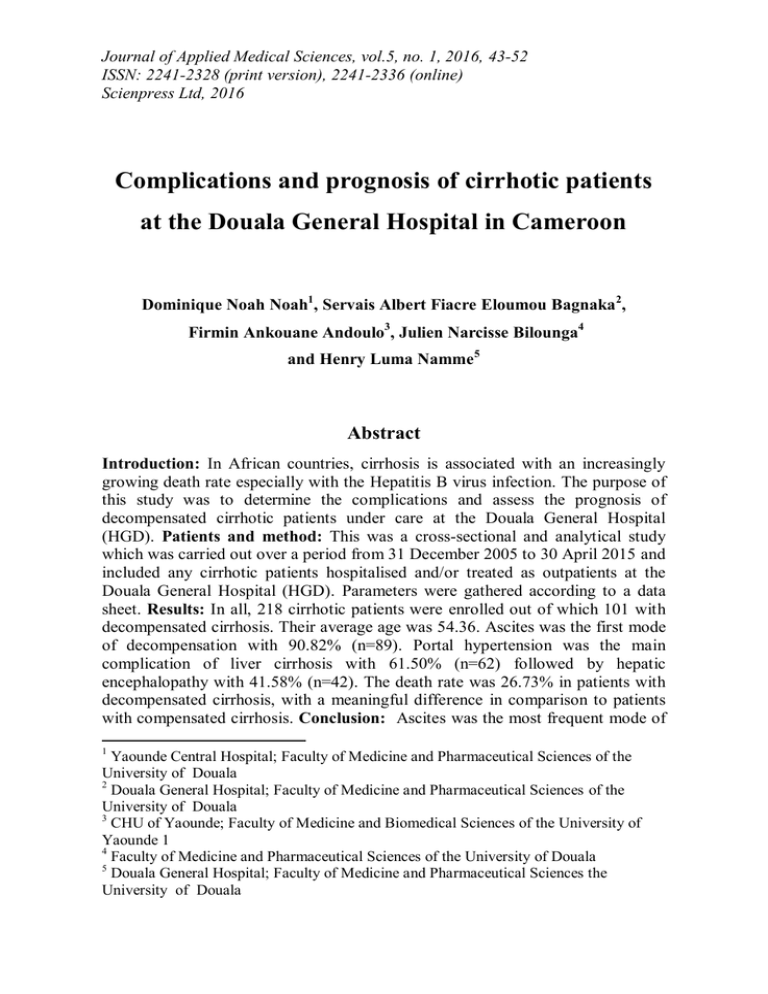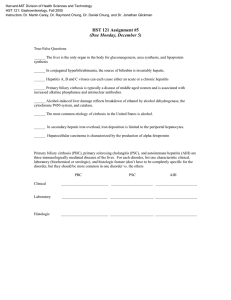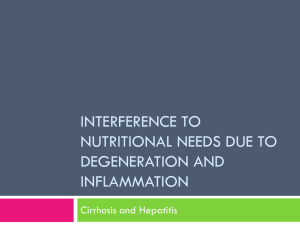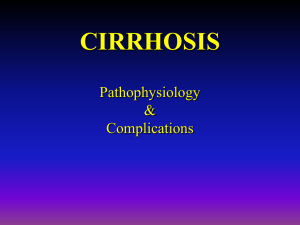Journal of Applied Medical Sciences, vol.5, no. 1, 2016, 43-52
advertisement

Journal of Applied Medical Sciences, vol.5, no. 1, 2016, 43-52 ISSN: 2241-2328 (print version), 2241-2336 (online) Scienpress Ltd, 2016 Complications and prognosis of cirrhotic patients at the Douala General Hospital in Cameroon Dominique Noah Noah1, Servais Albert Fiacre Eloumou Bagnaka 2, Firmin Ankouane Andoulo3, Julien Narcisse Bilounga4 and Henry Luma Namme5 Abstract Introduction: In African countries, cirrhosis is associated with an increasingly growing death rate especially with the Hepatitis B virus infection. The purpose of this study was to determine the complications and assess the prognosis of decompensated cirrhotic patients under care at the Douala General Hospital (HGD). Patients and method: This was a cross-sectional and analytical study which was carried out over a period from 31 December 2005 to 30 April 2015 and included any cirrhotic patients hospitalised and/or treated as outpatients at the Douala General Hospital (HGD). Parameters were gathered according to a data sheet. Results: In all, 218 cirrhotic patients were enrolled out of which 101 with decompensated cirrhosis. Their average age was 54.36. Ascites was the first mode of decompensation with 90.82% (n=89). Portal hypertension was the main complication of liver cirrhosis with 61.50% (n=62) followed by hepatic encephalopathy with 41.58% (n=42). The death rate was 26.73% in patients with decompensated cirrhosis, with a meaningful difference in comparison to patients with compensated cirrhosis. Conclusion: Ascites was the most frequent mode of 1 Yaounde Central Hospital; Faculty of Medicine and Pharmaceutical Sciences of the University of Douala 2 Douala General Hospital; Faculty of Medicine and Pharmaceutical Sciences of the University of Douala 3 CHU of Yaounde; Faculty of Medicine and Biomedical Sciences of the University of Yaounde 1 4 Faculty of Medicine and Pharmaceutical Sciences of the University of Douala 5 Douala General Hospital; Faculty of Medicine and Pharmaceutical Sciences the University of Douala 44 Dominique Noah Noah et al. cirrhosis decompensation in our context. Portal hypertension was the main complication in patients with decompensated cirrhosis. Mortality was significantly higher in patients with decompensated cirrhosis than in those with compensated cirrhosis (p<0.001). Key words: Decompensated cirrhosis; Complications; general hospital; Douala. 1 Introduction Cirrhosis is defined as an irreversible hepatic architecture impairment resulting from progressive fibrosis and characterized by the development of regenerating nodules and a chronic, sustained inflammatory response [1]. Previously assumed to be final stage of the chronic liver disease after years of progression, it is nowadays considered as a pathological process with potential for progression or regression of hepatic fibrosis, hence the new name «Advanced Stage of Chronic Liver Disease (ACLD)» [2, 3, 4]. In Europe, cirrhosis is responsible for 170 000 fatalities per year, that is 1.5% of death cases, among which about one-third caused by hepatocellular carcinoma [5]. In the United States of America, it was the eighth main cause of mortality in 2010 with approximately 49 500 death cases, while with 18% in Mexico it represented the fourth main cause of death in humans from 40 to 49 years old [6, 7]. In India, mortality associated with liver cirrhosis was estimated at 18.3% of the global rate of deaths due to cirrhosis [7]. In Northern Africa, Egypt especially, death rate attributed to cirrhosis was estimated at 18% in men between 45 and 54 in 2010 while in Sub-Saharan Africa the rate doubled between the years 1980 and 2010 [7]. The natural process of cirrhosis is characterized by a compensation phase and a decompensation phase during which complications such as ascites, encephalopathy, jaundice, and stomach haemorrhage occur [8]. Hepatocellular carcinoma is the third cause of death after cancer in the world as it affects 30% of cirrhotic patients [9]. Such complications are secondary to portal hypertension and hepatocellular insufficiency [1]. Therefore, cirrhosis is considered as a severe and potentially fatal disease [10]. In Cameroon there has been very little research on this issue. However, Nko’o et al. reported a cirrhosis prevalence rate of 35% in all cases of liver diseases in 1992 [14]. The aim of this study was to determine the complications and evaluate the prognosis of patients with decompensated cirrhosis whose progress is being monitored at the Douala General Hospital (HGD). Complications and prognosis of cirrhotic patients... 45 2 Methodology This was a cross-sectional, analytical study undertaken in the Internal Medicine department of the Douala General Hospital. The research was carried out in two phases: a retrospective phase from 31st December 2005 to 1st January 2015 and a prospective phase from 1st January 2015 to 30 April 2015. Patient records were systematically reviewed during the retrospective phase. The prospective phase consisted in enrolment of hospitalised cirrhotic patients and those treated as outpatients. A questionnaire was prepared taking into account patient’s case history concerning viral hepatitis B or C infection and consumption of alcoholic beverages. Patient clinical and para-clinical data ware also collected. Included were all cirrhotic patients whose progress was monitored at the internal medicine department of the Douala General Hospital (HGD). The diagnosis of cirrhosis was based on clinical (hepatomegaly with a sharp lower edge, collateral venous circulation, signs of hepatocellular failure…) and ultrasonic (heterogeneous and nodular hepatic parenchyma, dented outlines, with enlarged segment I or caudate lobe, signs of portal hypertension with an increase in size of the spleen) and/or biological (prothrombin below 70%) criteria. Non-cirrhotic patients and any cirrhotic patient who died in the emergency department or with evidence of oedemato-ascitic decompensation of non-hepatic origin were not included. The data were processed and analysed with the help of the Word 2010, Epi-Info version 7, Excel 93-2007 software. The quantitative variables were expressed in terms of averages, standard deviations and medians and the qualitative variables in terms of frequencies. Bivariate analyses were made using the Chi-Square test and the Student’s t-test. The significance threshold was P<0,05. 3 Results In all, we have enrolled 218 cirrhotic patients including 101 with decompensated cirrhosis, about 46.33%. The man to woman ratio was equal to 1.2. The average age was 54.36 ± 16.65 years with a minimum of 12 years and a maximum of 89 years. The 56-65 age group was predominant and represented 27.06% of the sample (table 1). 46 Dominique Noah Noah et al. Table 1: Types of cirrhosis distribution by gender (n=218) Gender identity Compensated Decompensated p OR [IC 95%] Male 47.86% 56.44% 0.2 0.7 [0.4-1,2] Female 52.14% 43.56% Table 2 shows the various patterns of cirrhosis decompensation in our series where ascites is predominant with 90.82% (n=89) Table 2: Patterns of cirrhosis decompensation (n=101) Type of decompensation Number of patients Percentage (%) (n) Ascites 89 90.82 Leg oedema 69 68.32 Icterus 34 33.66 Portal hypertension was predominant among the various complications with 61.5% (n=62), followed by hepatic encephalopathy 41. 58% (n=42). Ascitic fluid infection was the least accounted for complication with 11.88% (n=12). (table 3) Complications and prognosis of cirrhotic patients... 47 Table 3: Distribution of decompensated cirrhosis complications (n=101). Complications Number of patients (n) Percentage (%) Portal hypertension 62 61.5 Encephalopathy 42 41.58 Hepatocellular carcinoma 24 23.76 Hepatorenal syndrome 15 14.85 Ascitic fluid infection 12 11.88 Multivariate analysis of the various risk factors involved in the genesis of cirrhosis and the appearance of complications show that post-viral hepatitis C cirrhoses present the poorest prognosis (table 4). Table 4: MELD scores according to risk factors (n=101) <9 10-19 20-29 29-30 > 40 n(%) n(%) n(%) n(%) n(%) HBV 1 (50) 11 (52.38) 8 (30.76) 3 (14.28) 9 (29.03) 0.003 HCV 2 (100) 7 (33.33) 12 (46.15) 14 (66.66) 16 (51.61) 0.05 Alcohol 1 (50) 6 (28.57) 8 (30.76) 5 (23.80) 10 (32.25) <0.01 HBV+C 0 (0) 1 (4.76) 0 (0) 1 (4.76) 0 (0) 0.47 HBV+ Alcohol 0 (0) 2 (9.52) 1 (3.84) 0 (0) 2 (6.45) 0.03 HCV+ Alcohol 0 (0) 1 (4.76) 1 (3.84) 2 (9.52) 2 (6.45) 0.59 HVB= hepatitis B virus; HCV= hepatitis C virus p 48 Dominique Noah Noah et al. Patients with decompensated cirrhosis had higher mortality rates than those with compensated cirrhosis. There was a meaningful difference between this mortality and decompensation (p<0,001) (table 5) Table 5: Mortality rate from cirrhosis (n=218) Death rate 4 Compensated n(%) Decompensated n(%) Total P 2(1,70) 27(26,73) 29 <0,001 Discussion It appears after our analysis that the average age was 54.3±16 years with extremes of 16 and 89 years. This average age is below that of the study by Dimitrios et al. in Greece in 2013, which was 67 years [11]. But it is higher than that which was found by Bouglouga et al. in Togo in 2010, which was 45 years in Togo in 2010 [12]. This young age could be justified by the hepatitis B virus infection in Africa where mother-to-child transmission and perinatal infection account for 50 to 75% of all cases of contamination [13]. . Male patients were the majority group compared to females with a man to woman ratio equal to 1.2. Literature data also point to the infection by the hepatitis B virus being male in most cases [14]. The male patients developed more decompensated cirrhosis (56.44%) than the female patients. This result is comparable to those obtained by several African studies [15, 16, 17, 18]. This could be linked to the fact that HBsAg seroconversion is lower in males than in females [19]. As cites was the most frequently occurring mode of decompensation with 90.82 % (n=89) followed by leg oedema and icterus respectively. This result is comparable to those obtained by Dia et al. in Senegal in 2010 and Ouavène et al. in the Central African Republic in 2008; they had got an frequency of ascites of 80.00% and 96.50% [20]. This result could be justified by the fact that ascites is one of the early clinical manifestations in case of hepatitis. Moreover the high incidence of the ictero-oedemato-ascitic decompensation is the sign of advanced stage of the disease at the moment of the diagnosis [21]. Portal hypertension was the most frequent complication in 61.50 % of cases. This portal hypertension most often manifested itself by stomach bleeding. This high Complications and prognosis of cirrhotic patients... 49 frequency is also found in the study by Bassène et al. in Senegal in 2012 (94.30%) [22]. Conversely, in Greece, Dimitrios et al. had noted the frequency of portal hypertension to be at 6.50% in 2013 [12]. This could be explained by the fact that patients go to the hospital when the disease has reached the stage of complications [12.22]. Hepatic encephalopathy was identified under this work in 41.58% of the cases. This frequency is below that of Diara et al. in Mali in 2010 (96.4%) and above those of Apica et al. in Uganda in 2013 (36.5%), Berzigotti et al. in Spain in 2011 (31%), Camengo et al. in CRA in 2013 (22,3%) and Dia et al. in Senegal in 2010 (20%) [16, 23, 24, 25]. Hepatocellular carcinoma (HCC) represented 23.76% of the cases. This frequency is comparable to that in the study by Camengo et al. in the CRA (20.2%). Conversely, it is lower than that of Diara et al (50.87%) and higher than those of Apica et al. (13.5%) and Monica et al. (3.8%). Such differences might be explained by the fact that HCC is a major complication that is very frequent in the course of cirrhosis of the liver requiring periodic ultrasound monitoring in patients with cirrhosis [16, 23, 25, 26]. Hepatorenal syndrome was identified in 14.85% of the cases. The frequency is lower than those of Dimitrios et al. (21.6%) and Diara et al. (19.29%) and Dia et al. (16.36%). But it is higher than those of Monica et al. (2.9%) and Camengo et al. (2.2%). [12, 16, 25, 26, 27]. Ascitic fluid infection (AFI) was identified in 11.88% of the cases. Its frequency is below those in the studies by Diara et al. (33%), Tsung-Hsing et al. (28.2%), Dia et al. (27.3%) and Camengo et al. (23%). These frequencies could explain why AFI occurs in 8 to 30% of cirrhotic patients with a death rate 2 to 5 times higher than that of non-infected patients [16, 25, 28, 29]. Regarding the survival of cirrhotic patients, the MELD scores were very unfavourable to decompensated cirrhoses compared to the compensated ones. The difference was meaningful especially concerning alcoholic cirrhoses (p<0,01) and alcohol and hepatitis B co-infections (p<0,03). These data are similar to those of Monica L et al. who demonstrated that mortality is higher among patients whose cirrhosis is decompensated (9.1%) than among those with compensated cirrhosis (2.1%) [26]. In this study published in the USA in 2015, the author showed that mortality rates have reduced despite everything, in both groups from 2002 to 2010, irrespective of age and co-morbidities thanks to progress in treatment and technological advances [26]. 50 Dominique Noah Noah et al. 5 Conclusion Cirrhosis remains a progressive disease whose short-term and even middle-term complications and prognosis are severe in our context. If therapeutic advances and technological breakthrough have helped improve the prognosis in Western countries, it remains important for us to prevent risk factors that include essentially viral hepatitis B and C and alcoholism. Conflicts of interest No conflicts of interest References [1] L.E.Zamora Nava, J.A. Valadez, N.C. Chavez-Tapia, A. Torre, Acute-onchronic liver failure, Ther Clin Risk Manag, 23(10), (2014), 295-303. [2] J. Wiegand, T. Berg, The Aetiology, Diagnosis and Prevention of Liver Cirrhosis, .DeutschesArzteblattInternational, 110(6), (2013), 85-91. [3] G. Garcia-Tsao, S. Friedman, J. Iredale, M. Pinzani, Now there are many (stages) where before there was one: in search of pathophysiological classification of cirrhosis. Hepatology, 51(4), (2010), 1445-9. [4] P. Hytiroglou, D.C. Snover, V. Alves, C. Balabaud, P.S. Bhathal, P. BioulacSage et al., Beyond “cirrhosis”: a proposal from the International Liver Pathology Study Group, Am J ClinPathol, 137(1), (2012), 5-9. [5] V.M. Seraina, M. Beat, Cirrhose hépatique : potentiel de progression et régression. FM S 15(5), (2015), 100-105. [6] S. Nusrat, M.S. Khan, J. Fazili, M.F. Madhoun, Cirrhosis and its Complications: Evidence Based treatment. World J.Gastroenterol, 20 (18), (2014), 5442-5460. [7] A.A. Mokdal, A.A. Lopez, S. Shahraz, R. Lozano, H. Mokdad Ali, J. Stanaway et al., Liver cirrhosis morality in 187 countries between 1980 and 2010: a systematic analysis. BMC Medecine, 12, (2014), 145. [8] A. Zipprich, G. Garcia-Tsao, S. Rogowski, W.E. Fleig, T. Seufferlein, M.M. Dollinger, Prognostic indicators of survival in patients with compensated and Complications and prognosis of cirrhotic patients... 51 decompensated cirrhosis, National Institutes of Health Liver international, 32 (9), (2012), 1407-1414. [9] J. Bruix, M. Sherman, Management of Hepatocellular Carcinoma J Hepatol, 42(5), (2005), 1208-36 [10] M.P. Radosavljevic, P. Angeli, J. Cordoba, O. Farges, D. Valla, Managing complications in cirrhosis patients, United European J.Gastroenterol, 3(1), (2015), 80-94. [11] A.S. Nko’o, P. Koki Ndombo, M. Biwolé Sida, A. Afane Ela, E. Afane Ze, L. Kayembe Tanga et al., Valeur diagnostique de l’échographie abdominale dans la cirrhose du noir africain : à propos de 99 cas. Annales de gastroenterology, 28(2 ), (1992), 61-64. [12] N.S. Dimitrios, Clinical outcomes of compensated and decompensated cirrhosis: a long term study, World J of Hepatology, 6(7), (2014), 504-512. [13] T. Moreira Diop, Atelier sur introduction des nouveaux vaccins dans PEV en Afrique francophone, révision des connaissances et considération des besoins en formation, Saly, Sénégal, 2003. [14] D.M. Parkin, F. Bray, J. Ferlay et al., Global cancer statistics 2002. CA cancer J Clin, 55, (2005), 74-108 [15] O. Bouglouga, M.A. Bagny, L.M. Lawson-Ananissoh, L. Kaaga, M.A. Djibril, D. Redah et al., Evaluation du coût financier direct de la prise en charge de la cirrhose et des complications dans le service d’hépatogastroentérologie du CHU-Campus de Lomé (Togo). Rev. Med. Madag, 3(1), (2013), 235-239. [16] M. Diarra, A. Konaté, A. Soukho, M. Dicko, A. Kallé, A. Doumbia épouse Samaké et al., Aspects évolutifs de la maladie cirrhotique dans un service d’hépato gastroentérologie au Mali. Mali Med, 15(1), (2010). [17] J.O. Ouavene, B. Koffi, T. Mobima, C. Bekondji, A. Massengue, A. Kossi Guenebem et al., Cirrhose du foie à l’hopital de l’amitié de Bangui. Aspects épidémiologiques, cliniques, échographiques et problèmes de diagnostic. JAIM, 5 (1), (2013). [18] M. Donofrio, E. Martone, S. Brunelli et al., Acuracy of ultrasound in the detection of liver fibrosis in chronic viral hepatitis. Radiol. Med (Torino), 110 (4), (2005), 341-8. [19] B. Al-Nakib, W. Nakib, A. Bayoumi, H. Al-Liddawi, A. ABashir, Hepatitis B virus (HBV) markers among patients with chronic liver diseases in Kuwait, 52 [20] [21] [22] [23] [24] [25] [26] [27] [28] [29] Dominique Noah Noah et al. Trans R soc Trop Med Hyg, 76 (3), (1982), 348-350. K. Asma Ouakaa, A. Najet, A. Nabil, A. Msadek, M. Nabyl Ben, D. Mohamed Hedi et al., Survie chez le cirrhotique Tunisien. Tunis Méd, 88 (11), (2010), 804-808. B.S. Apica, P. Ocama, E. Seremba, K.C. Opio, M.M. Kagimu, Decompensated cirrhosis-related admission in large urban hospital in Uganda. Prevalence, clinical and laboratory features and complications for planning patient management, African Health Sciences, 13 (4), (2013), 927932. M.L. Bassène, M.L. Diouf, D. Dia, M. Mbengue, A. Halim, S. Diallo et al., Ligature élastique des varices oesophagiennes à Dakar (Sénégal). Méd Santé Trop, 22, (2012) 116-169. J.P. Benhamou, S. Erlinger, Maladies du foie et des voies biliaires 5e édition. Paris: Flammarion 2007, 220p. A. Berzigotti, G. Garcia-Tsao, J. Bosch et al., Obesity in an independent risk factor for clinical decompensation in patients with cirrhosis. Hepatology, 54 (2), (2011), 555-561. S.M. Camengo Police, B. Koffi, N. Boua-Akelelo, M. Mbeko Simaleko, D. Mossomo Kpinde, J.D. Longo et al., Les complications de la cirrhose à l’hopital universitaire de l’amitié de Bangui (RCA). J A fr HépatoG, 7, (2013), 78-81. L.S. Monica, A. Sidney Barritt, S.O. Eric, H.H. Paul, Decreasing mortality among patients hospitalized with cirrhosis in the United-States from 2002 through 2010. Gastroenterology, 148, (2015), 967-977. D. Dial, Y.K. Serme, M.L. Bassène, A. Halim, S. Diallo, M.A. Thioubou et al., Infection spontanée du liquide d’ascite à Dakar, Sénégal. Etude de 55 patients cirrhotiques, Médecine et santé tropicale, 24, (2014), 55-57. H. Tsung-Hsing, T, Chih-Wei, H. Yu-Hsi, T. Kuo-Chih, T. Chih-Chun, T. Chen-Chih et al., High mortality of pneumonia in cirrhotic patients with ascites, BM C Gastroenterology, 13, (2013), 25. M. Younsi El, Histoire naturelle de la cirrhose du foie. Indicateurs pronostiques et complications. Esp Med, 13 (129), (2006), 375-378.






